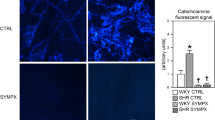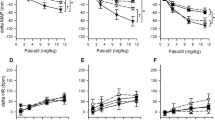Summary
A considerable amount of data suggest the involvement of calcium-mediated processes in the activation of the renin-angiotensin-aldosterone (RAA) cascade. To investigate the effect of calcium-channel inhibition on the RAA system, we studied 21 conscious pigs. Blood renin and aldosterone levels increased by subjecting animals to 24 hours of immobilization stress. Renin and aldosterone levels were repeatedly measured by radio-immunoassay in blood samples taken periodically over 24 hours from a chronically implanted arterial cannula. Pretreatment of the animals (N = 11) with nisoldipine, 2 × 20 mg p.o. daily for 2 days before and on the day of immobilization, transiently attenuated the stress-induced increase of plasma renin activity and completely prevented the rise of aldosterone, as compared to nontreated controls (N = 10). The finding that nisoldipine suppresses RAA activation induced by a nonpharmacologic stimulus in the conscious intact animal may have clinical implications.
Similar content being viewed by others
References
Laragh JH, Sealey JE. The renin-angiotensin-aldosterone system in hypertensive disorders: A key to two forms of arteriolar vasoconstriction and a possible clue to risk and vascular injury (heart attack and stroke) and prognosis. In: Laragh JH, Brenner BM, eds.Hypertension. Pathophysiology, diagnosis and management. New York: Raven Press, 1990:1329–1348.
Michorowski B, Ceremuzynski L. The renin-angiotensinaldosterone system and the clinical course of acute myocardial infarction.Eur Heart J 1983;4:259–264.
Fakunding JL, Catt KJ. Dependence of aldosterone stimulation in adrenal glomerulosa cells on calcium uptake; effects of lanthanum and verapamil.Endocrinology 1980;107: 1345–1353.
Johnson EJM, McDougal JG, Coghlan JP, et al. Role of CA++ in response of aldosterone to stimulation by angiotensin II in vivo.Am J Physiol 1988;254:E566-E571.
International Committee for Laboratory Animals. Guidelines for the regulation of animal experimentation. ICLA Special Reprint No. 7. ICLA Secretariat, ed. National Institute of Public Health. Postuttak Oslo 1, Norway, 1971.
Axelrod J, Reisine TD. Stress hormones: Their interaction and regulation.Science 1984;224:452–459.
Althen TG, Ono K, Topel DG. Effect of stress susceptibility or stunning method on catecholamine levels in swine.J Anim Sci 1977;44:985–989.
Mason JW, Mangan G Jr. Brady JV, et al. Concurrent plasma epinephrine, norepinephrine and 17-hydroxycorticosteroid levels during conditioned emotional disturbances in monkeys.Psychosom Med 1961;23:344–353.
Haggendal J, Jonsson L, Johansson G, et al. Catecholamine-induced free radicals in myocardial cell necrosis on experimental stress in pigs.Acta Physiol Scand 1987;131: 447–452.
Oates J, Whorton AR, Gerkens JF, et al. The participation of prostaglandins in the control of renin release.Fed Proc 1979;38:72–74.
Fakunding JL, Chow R, Catt KJ. The role of calcium in the stimulation of aldosterone production by adrenocorticotropin, angiotensin II and potassium in isolated glomerulosa cells.Endocrinology 1979;105:327–333.
Burn JH, Gibbons WR. The release of noradrenaline from sympathetic fibres in relation to calcium concentrations.J Physiol 1965;181:214–233.
Armstead WM, Lippton HL, Hyman AL, et al. Influence of nisoldipine on vascular responses in cats.Am J Physiol 1987;252:H816-H825.
Roy MW, Guthrie GP, Holladay FP, Kotchen TA. Effects of verapamil on renin and aldosterone in the dog and rat.Am J Physiol 1983;245:E410-E416.
Park, CS, Han DS, Fray JSC. Calcium in the control of renin secretion: Ca++ influx as an inhibitory signal.Am J Physiol 1981;240:F70-F74.
Naftilan AJ, Oparil S. The role of calcium in the control of renin release.Hypertension 1982;4:670.
Moe GW, Karlinsky SJ, Frankel D, et al. Intravenous nisoldipine in severe congestive heart failure.J Cardiovasc Pharmacol 1988;12:160–166.
Kiowski W, Erne P, Pfisterer M, et al. Hemodynamic effects of nisoldipine in patients with severe chronic congestive heart failure. In: Hugenholtz PG, Mezer J, ed.Nisoldipine 1987. Berlin: Springer-Verlag 1987:329–342.
Johnson EL, McDougall JG, Coghlan JP, et al. Potassium stimulation of aldosterone secretion in vivo is reversed by nisoldipine, a Ca++ transport antagonist.Endocrinology 1984;114:1466–1468.
Author information
Authors and Affiliations
Rights and permissions
About this article
Cite this article
Ceremuzyński, L., Kloś, J., Barcikowski, B. et al. Calcium channel blocker prevents stress-induced activation of renin and aldosterone in conscious pig. Cardiovasc Drug Ther 5, 643–646 (1991). https://doi.org/10.1007/BF03029733
Issue Date:
DOI: https://doi.org/10.1007/BF03029733




